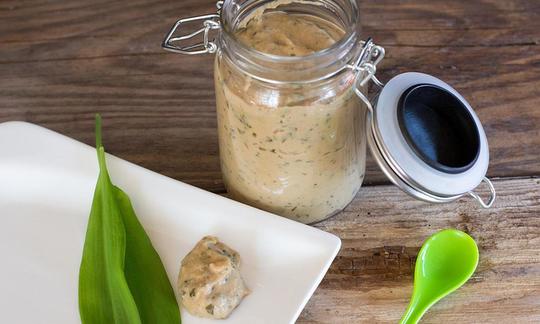Wild Garlic Mustard with Ginger, Maple Syrup, and White Wine
vegan
Ingredients (for servings, )
| Wild garlic mustard, with or without white wine | |
|---|---|
| 3 ½ oz | Mustard seeds, yellow-white (raw, organic?) |
| ⅛ oz | White pepper (organic?, raw?) |
| 1 tsp | Ginger, raw (organic?) (0.07 oz) |
| 1 clove | Garlic (organic?) (0.11 oz) |
| 3 ¼ oz | Wild garlic, raw (organic?) |
| 1 oz | Maple syrup (organic?, raw?) |
| ½ tsp | Table salt (table salt, raw?, organic?) (0.11 oz) |
| 100 ml | White wine vinegar (raw?, organic?) (3.5 oz) |
| Optional | |
| 100 ml | Table wine, white (raw?, organic?) (3.5 oz) |
Equipment
- vegetable peeler
- coffee grinder, electric
- sieve
- canning jar (Weck jar, Mason jar)
Type of preparation
- chop or grind
- food preparation without heating
- meld
- remove the skin
- peel
- sift
Preparation
Preparing the wild garlic mustard
Finely grind the mustard seeds together with the white pepper (peppercorns) in an electric coffee grinder.If you want the mustard to be smoother, you can strain out any remaining mustard seeds and run them through the coffee grinder again.
Peel the garlic clove and ginger, cut into pieces, and grind to a fine paste in the electric coffee grinder.
Clean and finely chop the wild garlic. Combine all of the ingredients and stir until a creamy paste is achieved.
Rinse the wild garlic well. This is important because, depending on where it was picked, the danger of fox tapeworm (Echinococcus multilocularis) infections cannot be ruled out.
Transfer the wild garlic mustard to a clean bowl and smooth it out with the back of a spoon. Let it rest overnight because the flavor and sharpness develops through oxidation and fermentation. If necessary, add a little water or white wine.
Without white wine: Replace the white wine with two equal amounts of water and white wine vinegar. In this case, the 100 mL of white wine can be replaced with about 50 mL of water and 50 mL of white wine vinegar.
Final steps and storing
Transfer the wild garlic mustard to clean jars and close tightly. Then store at least two weeks in a cool, dark place to allow the mustard time to develop its full flavor. If you use it earlier, it will taste tangy and bitter.
|
Nutritional Information per person
Convert per 100g
|
2000 kcal | |
|---|---|---|
| Energy | 71 kcal | 3.5% |
| Fat/Lipids | 2.9 g | 4.2% |
| Saturated Fats | 0.16 g | 0.8% |
| Carbohydrates (inc.dietary fiber) | 6.6 g | 2.4% |
| Sugars | 3.7 g | 4.1% |
| Fiber | 0.91 g | 3.7% |
| Protein/Albumin | 2.6 g | 5.3% |
| Cooking Salt (Na:119.2 mg) | 303 mg | 12.6% |
| Essential micronutrients with the highest proportions | per person | 2000 kcal | |
|---|---|---|---|
| Prot | Tryptophan (Trp, W) | 0.05 g | 21.0% |
| Fat | Alpha-Linolenic acid; ALA; 18:3 omega-3 | 0.39 g | 19.0% |
| Min | Manganese, Mn | 0.34 mg | 17.0% |
| Vit | Vitamin C (ascorbic acid) | 14 mg | 17.0% |
| Min | Iron, Fe | 2.2 mg | 16.0% |
| Sodium, Na | 119 mg | 15.0% | |
| Elem | Phosphorus, P | 94 mg | 13.0% |
| Prot | Threonine (Thr, T, irreversibly transaminated) | 0.11 g | 12.0% |
| Vit | Vitamin B3 (Niacin) | 1.7 mg | 11.0% |
| Elem | Magnesium, Mg | 36 mg | 10.0% |
Detailed Nutritional Information per Person for this Recipe
The majority of the nutritional information comes from the USDA (US Department of Agriculture). This means that the information for natural products is often incomplete or only given within broader categories, whereas in most cases products made from these have more complete information displayed.
If we take flaxseed, for example, the important essential amino acid ALA (omega-3) is only included in an overarching category whereas for flaxseed oil ALA is listed specifically. In time, we will be able to change this, but it will require a lot of work. An “i” appears behind ingredients that have been adjusted and an explanation appears when you hover over this symbol.
For Erb Muesli, the original calculations resulted in 48 % of the daily requirement of ALA — but with the correction, we see that the muesli actually covers >100 % of the necessary recommendation for the omega-3 fatty acid ALA. Our goal is to eventually be able to compare the nutritional value of our recipes with those that are used in conventional western lifestyles.
| Essential fatty acids | per person | 2000 kcal |
|---|---|---|
| Alpha-Linolenic acid; ALA; 18:3 omega-3 | 0.39 g | 19.0% |
| Linoleic acid; LA; 18:2 omega-6 | 0.28 g | 3.0% |
| Essential amino acids | per person | 2000 kcal |
|---|---|---|
| Tryptophan (Trp, W) | 0.05 g | 21.0% |
| Threonine (Thr, T, irreversibly transaminated) | 0.11 g | 12.0% |
| Isoleucine (Ile, I) | 0.11 g | 9.0% |
| Lysine (Lys, K, irreversibly transaminated) | 0.16 g | 8.0% |
| Valin (Val, V) | 0.13 g | 8.0% |
| Leucine (Leu, L) | 0.18 g | 7.0% |
| Phenylalanine (Phe, F) | 0.11 g | 7.0% |
| Methionine (Met, M) | 0.05 g | 5.0% |
| Vitamins | per person | 2000 kcal |
|---|---|---|
| Vitamin C (ascorbic acid) | 14 mg | 17.0% |
| Vitamin B3 (Niacin) | 1.7 mg | 11.0% |
| Vitamin B1 (Thiamine) | 0.07 mg | 6.0% |
| Vitamin B2 (Riboflavin) | 0.08 mg | 6.0% |
| Vitamin B6 (pyridoxine) | 0.05 mg | 3.0% |
| Vitamin A, as RAE | 19 µg | 2.0% |
| Vitamin B7 (Biotin, ex vitamin H) | 1.1 µg | 2.0% |
| Vitamin B5 (Pantothenic acid) | 0.07 mg | 1.0% |
| Vitamin B9, B11 (Folate, as the active form of folic acid) | 1.7 µg | 1.0% |
| Vitamin E, as a-TEs | 0.02 mg | < 0.1% |
| Vitamin K | 0.04 µg | < 0.1% |
| Essential macroelements (macronutrients) | per person | 2000 kcal |
|---|---|---|
| Sodium, Na | 119 mg | 15.0% |
| Phosphorus, P | 94 mg | 13.0% |
| Magnesium, Mg | 36 mg | 10.0% |
| Calcium, Ca | 65 mg | 8.0% |
| Potassium, K | 121 mg | 6.0% |
| Essential trace elements (micronutrients) | per person | 2000 kcal |
|---|---|---|
| Manganese, Mn | 0.34 mg | 17.0% |
| Iron, Fe | 2.2 mg | 16.0% |
| Zinc, Zn | 0.56 mg | 6.0% |
| Copper, Cu | 0.05 mg | 5.0% |
| Fluorine, F | 30 µg | 1.0% |
| Iod, I (Jod, J) | 0.82 µg | 1.0% |
| Selenium, Se | 0.08 µg | < 0.1% |
Wild garlic mustard develops a rich flavor when combined with fresh herbs, ginger, and maple syrup. The addition of white wine is optional.
Servings: We have set this recipe to the maximum number of servings (10) as mustard is usually only used in small amounts. The recipe for this number of servings should yield a little more than 200 grams of wild garlic mustard.
Why a cooked recipe: You do not have to heat any ingredients to make this recipe, but not all of the ingredients are available raw. For example, commercial maple syrup is not currently raw. Since its weight is almost 15 % of the total weight, we have listed this recipe under cooked recipes. If you use a different sweetener, this mustard will then be raw.
Wild garlic: For wild garlic mustard, it is best to use fresh wild garlic since heat alters its sulfurous ingredients, causing it to lose much of its characteristic flavor. If you gather your own fresh wild garlic, you should wash it well before eating. This is important because, depending on where it was picked, the danger of contamination with fox tapeworm eggs (Echinococcus multilocularis) infections cannot be ruled out.
Gathering wild garlic: Wild garlic can be found in almost all of Europe; in Switzerland it is in season from March to May. You have to be careful not to mistake lily of the valley, autumn crocuses, or arum lilies, all extremely poisonous plants, for wild garlic. You can be sure you’ve found wild garlic if the leaves have a strong garlic smell when you rub them together. However, this only helps at the beginning as the smell will stick to your hands. Another possibility is to use leaf identification. Whereas lily of the valley and autumn crocuses have several leaves on one stem, wild garlic has only one leaf per stem.
How the mustard flavor develops: Although yellow mustard has a spicy, sharp, and slightly nutty flavor, mustard seeds do not. The typical mustard flavor develops only after the seeds come into contact with liquids. This contact activates the enzyme myrosinase, which breaks down the glycoside sinalbin, the compound responsible for yellow mustard’s characteristic pungent aroma.
Maple syrup: This concentrated syrup tapped from maple trees is a vegan sweetener that is currently heated during the production process and is therefore not raw. The process came from the Indians who drilled holes in the stems of maple trees and collected the sap that was inside. The sap is then concentrated by cooking and the typical flavor (caramelization of the sugars) then develops. However, since caramelization only takes place at temperatures well above 42 °C, the product is no longer a raw food.
White wine: White wine is made using both red and white grapes that have a pale flesh. The grapes are processed directly after harvesting. Since processing is somewhat more complicated than with red wine and whiter varieties also appeared later, it can be assumed that the first wines were red wines. White wine contains much less histamine than red wine. Histamine can cause a number of unpleasant symptoms in individuals who have an histamine intolerance.
Grinding mustard seeds: Deep-freezing the mustard seeds before processing makes grinding easier. If you don’t have an electric coffee grinder available, you can instead buy ground mustard seed at a health food store or organic grocery store. However, freshly ground mustard seed has a fuller aroma than preground varieties from the store. And when you grind it yourself, you can decide how fine you want the grind to be.
Coarse and hot mustard: If you prefer a more coarse mustard, you can grind some of the mustard seeds less finely. Darker mustard seed will have a stronger flavor and be spicier. To obtain a more intense wild garlic mustard, replace about one-fifth of the yellow mustard seeds with brown or black seeds.
Without white wine: Replace the white wine with two equal amounts of water and white wine vinegar. In this case, the 100 mL of white wine can be replaced with about 50 mL of water and 50 mL of white wine vinegar.




